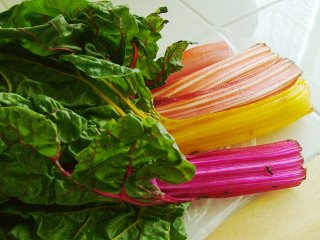There's a lot of talk about improving your health and palate by shopping at the edges of the supermarket--fresh fruits and vegetables, raw meats, and dairy--and avoiding all of the processed foods in the middle. I don't promise that I eat foods that are healthy, gourmet, or even interesting all the time, but I find that foods built from simple raw materials are often the most flavorful and personally rewarding.
 Swiss Chard
Swiss ChardSwiss chard has to be one of the most beautiful vegetables in the produce section. What you see here is commonly marketed as "rainbow chard", meaning that white, red, pink, and yellow varieties are grown separately and then bunched together for sale. Chard is closely related to the beet plant, though here the focus is on the stalks and leaves rather than the root.
The stalks are edible, though they have to cook longer than the leaves. Without any former experience with Swiss chard, I decided to take the common advice to "treat it like spinach". I cooked some pancetta, chopped the stalks, sautéed them in the pancetta grease, and then added the torn leaves to allow them to wilt and cook.
The end result? Interesting. Not delicious, but good enough on its own. A little bitter, but I like bitter flavors in my food and beer. It really needed some hard Italian cheese mixed in it, and I think it could definitely benefit from a cream-based sauce. With this round of produce experiments, I'm trying to discern the inherent flavors of these weird ingredients, and thus I can find a good use for them in the future.
For instance, I use spinach heavily whenever I make a vegetarian lasagna, so I think I'll substitute Swiss chard next time. I'll also be on the lookout for some traditional recipes that really show off the color and flavor. Still, it's a damned shame that you can't just serve the stuff raw in a salad. Perhaps used as garnish? Think about a half dozen pork ribs laid out along a broad leaf of red chard...

4 comments:
I'm a little late to the game here, but where are you getting Swiss chard that looks like that in Memphis? Most of what I see is pretty sickly.
Nice blog.:-)
Jen,
I get e-mail notices on all comments, so it's never too late to drop a note.
I'd like to say that I grew it myself or purchased it from some local organic farmer, but I picked up the Swiss chard at the Schnuck's in Cordova (corner of Germantown Parkway and Cordova Road). I've always been quite satisfied with their produce, meat, and seafood sections in terms of quality and freshness. Your mileage may vary throughout the city, and I have no idea what the ideal season is for Swiss chard, so that will probably have a role to play.
Cheers,
Benito
Thanks, Benito. I've heard that Shnucks is quite good. The grocery stores in East Memphis (or at least my part) are hit or miss, even at the likes of Fresh Market and Wild Oats (where it's got to be really fresh for me to pay those prices). Thanks for replying.
Best,
Jen
Jen,
Typically it's good to shop around. The store that has good carrots will have lousy parsnips. The farmer's market can be the source of exciting treasures or really bad potatoes. I've also seen a lot of variety within the individual stores of a particular chain.
Cheers,
Benito
Post a Comment